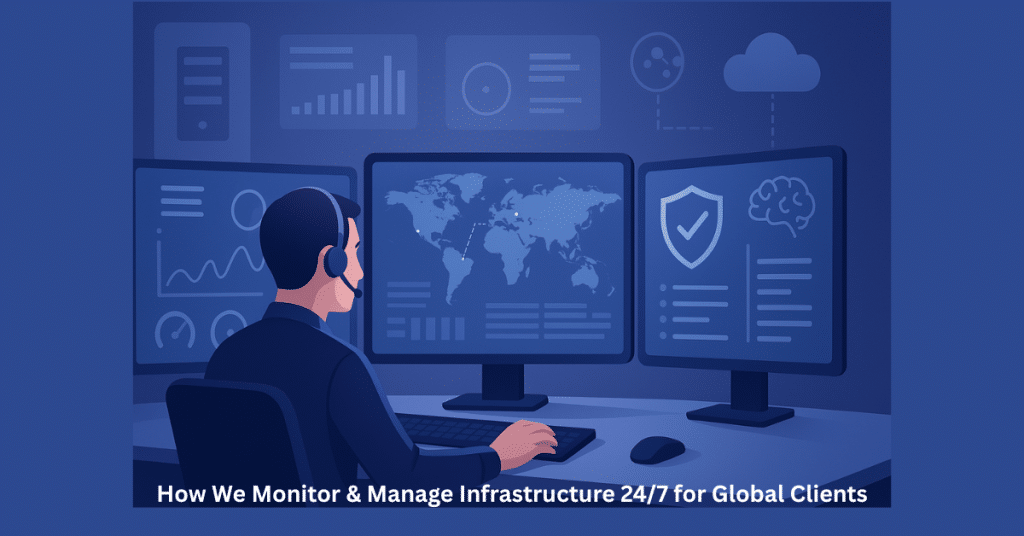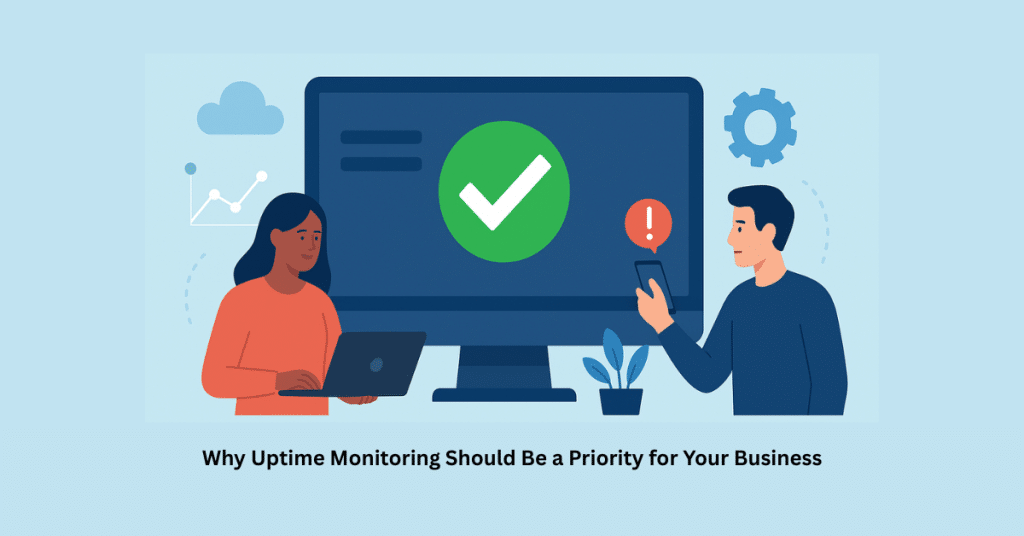With the hyper-connected digital world of today, monitoring your server environment alone is not enough. As companies grow, so does the scale of their IT infrastructure. Such growth calls for a change from reactive server monitoring to proactive server management—an strategy which not only detects issues early but also maximizes performance, minimizes downtime, and maximizes security.
For expanding businesses, the stakes are high. Customer needs, compliance requirements, and uptime reliability leave little latitude for mistakes. Adopting proactive server management is no longer a luxury—it’s a strategic necessity.
The Limitations of Traditional Monitoring
Traditional server monitoring software is set up to notify administrators when something goes awry—CPU spikes, memory abuse, or disk space depletion. Helpful as it is, this reactive strategy tends to put businesses in the position of responding after things go wrong, not preventing them from happening.
Severe constraints include:
- Delayed response: Alerts only trigger after a problem has occurred.
- Manual interventions: Often, human input is needed to analyze and fix issues.
- Limited insight: Static dashboards may lack context or predictive analytics.
- Operational silos: Monitoring may not be integrated with DevOps or security workflo
These systems’ reactive nature can contribute to performance degradation, security vulnerabilities, and users in frustration. For today’s businesses, this is unacceptable.
What Is Proactive Server Management?
Proactive server management entails ongoing optimization, automation, and risk-mitigation practices that work to avoid problems before they affect business.
This future-oriented strategy emphasizes:
- Automated health checks
- Predictive performance trends with analytics
- Real-time patching for security
- Resource forecasting
- Automated backups and disaster recovery drills
Instead of waiting for things to go wrong, proactive server management stays ahead of potential failures—delivering maximum uptime and performance.
Why Proactive Management is Needed by Growing Businesses
Growing businesses have specific challenges:
- Increased workload and user traffic
- Distributed IT environments (on-prem, cloud, hybrid)
- Regulatory compliance requirements
- Tighter SLAs and customer expectations
These challenges demand more than simple server monitoring.
A proactive approach has advantages like:
1. Enhanced Uptime and Reliability
Unplanned outages cost companies both reputation and revenue. With proactive monitoring and maintenance, system irregularities can be caught early on, reducing downtime.
2. Stronger Security Posture
In the world of cyber attacks, security patches and updates have to be instantaneous. Proactive systems can be programmed to carry out these functions, ensuring key vulnerabilities are handled quickly.
3. Performance Optimization
As the workload increases, bottlenecks in performance can occur. Proactive server management includes configuration tuning, load balancing, and capacity planning to maintain systems efficiently.
4. Predictable Costs
Reactive IT processes usually entail emergency support charges or costly downtime. Proactive management enables more predictable costing and controlled operational costs.
5. Improved Compliance and Reporting
Finance, healthcare, and e-commerce businesses necessitate stringent data handling regulations. Proactive servers can be configured to log activities automatically, implement encryption, and provide compliance-ready settings.
Key Elements of Proactive Server Management
Having a proactive process entails several interrelated elements. The following are necessary pillars of a solid enterprise server management structure.
1. 24×7 Monitoring with Predictive Insights
Whereas conventional server monitoring remains obligatory, today’s method incorporates AI-powered analytics. Machine learning algorithms are able to identify patterns that lead to outages or slow performance before they actually happen.
Prometheus, Zabbix, or commercial solutions may provide threshold-based warning, whereas machine learning may provide trend-based alerts.
2. Automated Patch Management
Overlooking a security patch might put your business at risk. Automation gets all the systems updated on time. This encompasses OS patches, middleware, web server upgrades, and database patches.
3. Configuration Management and Version Control
Ansible, Puppet, and Chef are some of the tools that enable system admins to treat infrastructure as code (IaC). This makes standardization, rollback, and consistency possible across different environments.
4. Backup and Disaster Recovery
Periodic backups are a given. But proactive measures also involve automated checks, off-site duplication, and disaster recovery (DR) drills to ensure readiness.
5. Capacity and Resource Planning
Proactive systems track CPU, memory, disk I/O, and network throughput to detect trends. If a server is reaching its capacity, alerts are triggered—or scaling is initiated automatically in cloud environments.
6. Security Audits and Vulnerability Scanning
Regular vulnerability scans can identify weak configurations or open ports. Firewalls, IDS/IPS, and endpoint protection must be proactively monitored and updated.
Proactive vs Reactive: A Side-by-Side Comparison
| Feature | Reactive Monitoring | Proactive Management |
| Issue Detection | After Failure | Before Failure |
| Performance Focus | Limited | Continuous Optimization |
| Cost | Unpredictable | Predictable |
| Downtime | Frequent | Minimal |
| Security Updates | Manual/Delayed | Automated/Timely |
| Compliance Readiness | Uncertain | Built-In |
Cloud Server Management: Proactive to the Power of Next
With cloud computing adoption, server environments become more complex. Cloud server management needs to consider:
- Dynamic workloads
- Auto-scaling groups
- Multi-region deployments
- Hybrid and multi-cloud strategies
Proactive server administration in the cloud includes:
- Utilizing Infrastructure as Code (IaC) to describe environments
- Auto-scaling rules to manage spikes in demand
- Cloud-native monitoring and security software (e.g., AWS CloudWatch, Azure Monitor)
- Cost optimization through usage analytics
Cloud platforms natively provide automation tools, making them perfect for proactive approaches—but only when well-tuned and monitored.
Managed Services vs In-House Management
While some companies host their servers in-house, many expanding businesses are looking toward managed service providers (MSPs). Advantages are:
- 24×7 technical assistance
- Access to enterprise-class solutions
- Security and compliance guarantee
- Less weight on in-house IT staff
An MSP that specializes in proactive server management offers scalability, responsibility, and peace of mind—opening up businesses to concentrate on innovation.
Challenges and Best Practices
Transitioning from reactive to proactive isn’t without challenges. Here are a few hurdles and how to overcome them:
Challenge 1: Cultural Resistance
Solution: Educate stakeholders on long-term benefits—such as reduced downtime, cost savings, and customer satisfaction.
Challenge 2: Legacy Systems
Solution: Use phased migration strategies and bridge tools to modernize gradually.
Challenge 3: Tool Overload
Solution: Consolidate platforms and dashboards to avoid siloed monitoring. Use integrated solutions where possible.
Best Practices:
- Establish rigorous SLAs for uptime, response time, and patching.
- Automate wherever possible—updates, checks, alerts.
- Auditing server environments for compliance and security vulnerabilities on a regular basis.
- Quarterly performance reviews and configuration optimization.
Final Thoughts
Monitoring is only the starting point. As businesses expand, so does the complexity and risk of IT operations. Proactive server management provides the reliability, agility, and security necessary to compete in this dynamic environment.
Whether you’re running a hybrid cloud infrastructure, growing e-commerce workloads, or serving global teams, a proactive stance guarantees your servers are ahead of what’s next.Rather than fighting fires, give your business the future-ready, intelligent infrastructure that works for you, not against you.



